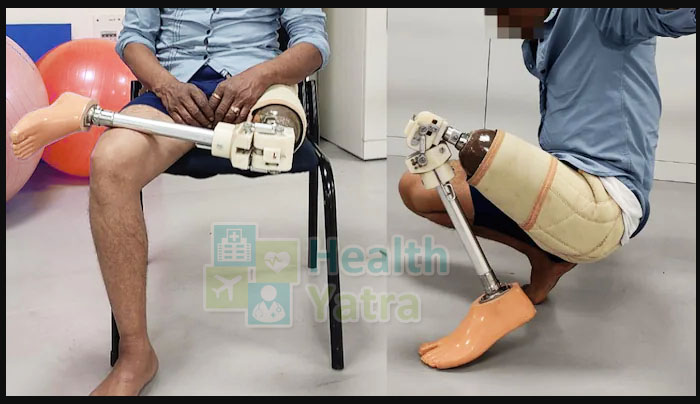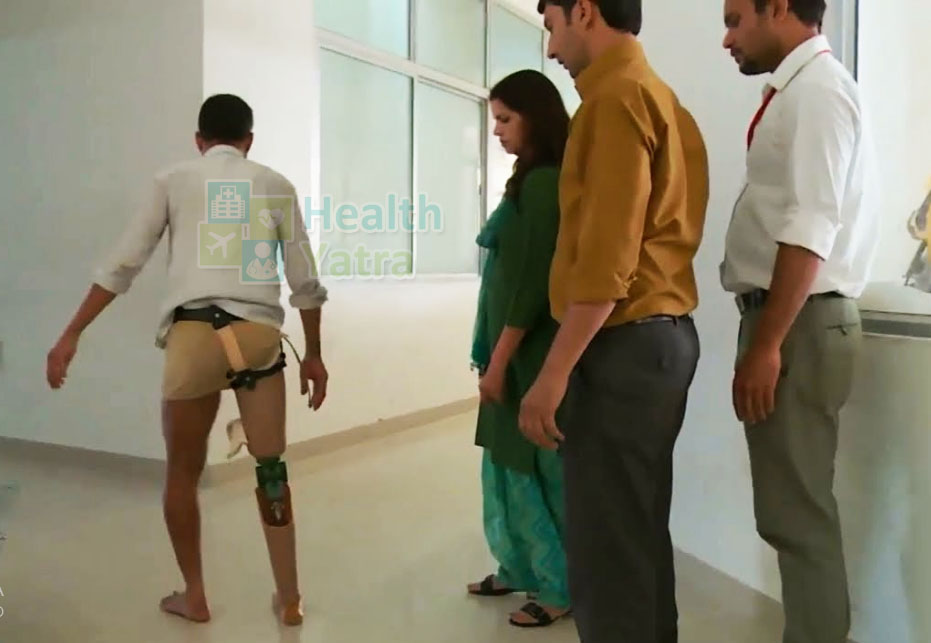Removal of a diseased or injured body part is called amputation. This may result from a traumatic injury or may be a planned operation meant to prevent spread of disease in infected finger, hand, or leg. Traumatically amputated fingers may at times be reattached or replanted. However, in several cases it may not be possible to reattach amputated finger, or may not be advisable if the patient is more comfortable or is able to have better function when the body part is unattached.
Amputation Surgery for Prosthetic Limb
Amputation operation is necessary for removing the injured body part before setting up an artificial limb. Orthopedic surgeons will conduct a careful examination of the involved limb prior to orthopedic surgery. Surgeons will obtain x-rays or other imaging tests so as to assess damage to the arm or leg parts. Area which is to be amputated will be based on the extent of injury & health of the remaining part of the body. Surgeons are able to close the site of surgery by shortening bone or tendon & rearranging skin in many cases. Surgeons may at times have to use tendons, muscle or skin from other parts of the body in order to close the site of surgery. However, surgeons are able to close the operation site directly in most cases of finger tip injuries. In other more extensive types of injuries, surgeons may have to shape finger, hand or leg, in order to be able to fit prosthesis at a later point of time. Patients should however expect some amount of pain during the first couple of weeks but which can be effectively controlled with pain medications. Surgeons will also teach patients how to bandage & take care of surgical site while healing including when they should return to the hospital for follow-up care. Patients will also be prescribed a regimen of exercises designed to increase strength & flexibility of extremities. Patients are often asked to touch & move skin so as to desensitize & keep it mobile.
Types of Prosthetic Limbs
The type of prosthesis which will be chosen depends upon the location & length of residual extremity & functional requirement of the patient including lifestyle needs. Quite often prosthesis replaces some function & appearance of missing parts of the body. It is therefore important that patients share with surgeons or prosthetists about the activities which they feel are most required so that an appropriate prosthesis can be provided. Most often, prosthesis can restore length to partially amputated fingers, enable opposition between thumb & finger or stabilize & hold objects with bendable fingers in case of a prosthetic hand. Patients whose hand is amputated through or above wrist may be provided full-arm prosthesis with a mechanical or electric hand. However, some patients may prefer not to use any prosthesis at all.
Making of an Artificial Limb
Prosthesis is usually made from an impression cast which is taken from residual limb or finger & the corresponding part of undamaged hand. This procedure is because it can create an exact match specific to details of the entire hand. Hand or finger prosthesis is made from transparent & flexible silicone rubber. Colors in silicone are then carefully matched to skin tone so as to give prosthesis a life-like look & texture matching real skin. The prosthesis is usually held on by suction while flexibility of silicone ideally permits good range of motion which is required from the remaining body parts. Fingernails can also be individually colored so as to perfectly match & blend with the surrounding tissue. Nails can be polished with nail polish & can also be removed with gentle-action nail polish remover. Silicones are typically resistant to staining; therefore inks easily wash off with alcohol or soap with warm water. Silicone prosthesis may last for up to 3 – 5 years with proper caring. Creation of prosthesis usually begins after 3 months when patients are completely healed from surgery & swelling has subsided. Prosthetic limb patients may also require therapy so as to learn to use the new prosthesis.
Osseointegration & Prosthetic Implants
Fitting a body part or prosthetic limb in a traditional way without any permanent attachment to the body can be too difficult to manage for some patients. This type of patients may benefit from osseointegration, which is a relatively new methodology designed to permanently attach prosthesis or artificial body part to the human body. Osseointegration associated with prosthetics involve inserting implants which are accepted by the body as part of bone & allow body part & artificial limb to permanently attach like joints & fittings. This type of prosthetic implant will not easily loosen & enable prosthesis become permanent. Titanium based prosthetic implants alone are known to possess this kind of property. Similar effect can also be obtained when metal implants are coated with special layer like hydroxyapatite which mimics bone. Specialized plastic surgeons are experienced in inserting osseointegrated prosthetic implants in neck & head regions. These surgeons also have experience in using prosthetic implants within the torso & upper leg areas.
Minimizing Risk of Infection in Patients Undergoing Osseointegration
Osseointegration of metal implants with bone is now an established & reliable process which is also well understood. However, allowing prosthetic implants to be useful for connecting with body part or an artificial limb, a part of the implant must stick out of the overlying skin so that the artificial limb can be secured to it. Nevertheless, a piece of metal permanently protruding through skin exposes the patient to certain amount of risk. Human skin has over millions of years evolved as a barrier between outside environment & the human body. Therefore, it poses a potential chance of infection every time this barrier is breached. Currently, there are two effective ways to reduce risk by developing a closer attachment between bone & skin.
- Thinning of soft tissues so that skin is directly attached to the periosteum of the underlying bone.
- Application of a skin graft directed to the outside of bone right next to the implant.
Emotional Recovery Following Prosthetic Limb Surgery
Loss of a part of body, especially those which are easily visible like legs, hands or fingers, can be quite upsetting. It may also take time for the patient to adapt to changes in appearance & the ability to carry on functioning. Talking to doctors & other patients regarding these feelings often helps patients come to terms with this loss. Doctors can also recommend counselors to patients so as to assist with this process. However, it is important for patients to remember that with time they will adapt to the changing situation & find newer ways of performing daily activities. It would also be worthy to remember that quality of life is directly related to attitude & expectations & not just obtaining & using prosthetic implants.
Affordable Prosthetic Limb Surgery in India
With the advent of plastic surgery procedures, need of prosthetic implants have surpassed functional requirements, to aesthetic appeal. Chin implants, breast lift/implants, pectoral implants, butt lift/implants & calf implants have all found their way into the human body. Surgical expertise has also immensely contributed to make this possible. Healthcare infrastructure in India is of exceptional standards & low cost when compared to availability in other parts of the globe. Many top hospitals in the country are NABH & JCI accredited & provide the latest advanced medical equipment for treatment. HealthYatra is one of the fastest growing medical tourism companies in South Asia & provides a one-stop online platform offering a variety of affordable healthcare solutions to people from all around the world. Hassle-free, prompt & seamless services offered by HealthYatra make them an ideal choice of international patients.
KEYWORDS: Affordable Prosthetic Limb Surgery in India, Prosthetic Limb Surgery Cost in India 2024, Prosthetic Limb Surgery in India, artificial leg manufacturers, cost of prosthetic limbs, artificial leg india, artificial leg above knee price in india, prosthetic hand cost in india, ottobock prosthetic leg price in india, ottobock artificial limbs, above knee artificial leg price, how much do prosthetics cost, how much does a prosthetic foot cost, best artificial limbs in india, cost of prosthetic leg in india, how to get a prosthetic leg for free, prosthetic hand cost in india, artificial leg below knee


